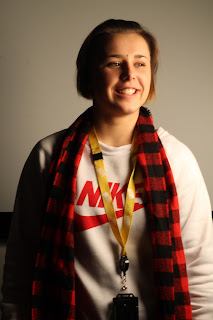Video Installation
The Concept
The
one, central theme I wanted for my video installation was ‘Happiness’. The idea
was to only show positive clips with the aim of making the audience smile. I
also liked the idea of the background music having the same theme of happiness
so wanted music that’s uplifting, in hopes of matching the clips used with the
music. I shot 98% of the footage myself, with the remainder being footage which
I found on YouTube.
Flying
is also a recurring theme in the video and this was used to show a feeling of
freedom and adventure. The video starts off with skydivers floating in the
skies before beginning their journey back to earth but before they start that
journey, the video jumps to the excitement as we surprise my little sister with
a trip to Disneyland Paris.
The
ideas I laid out in my storyboard were meant to capture happy moments from a
family holiday. We had planned a trip to
Disneyland and I knew that I wanted to capture visits to the Park as well as
other landmarks such as the Eiffel Tower.
I believe I captured these moments successfully and I managed to fulfil
much of the vision as laid out on the story board.
The
filming took place over a 5 day period from our journey to the airport to
flying back home.
Technology
I
filmed on the Canon 700D. Although it captured everything, I believe that the
picture quality would have been even sharper had I used another camera, for
example the Canon EOS 5D Mark III. I used Final Cut Pro X to edit which I have
used many times before and find it quite easy to use.
Music
I
wanted the music to be upbeat, in line with the theme of ‘happiness’. I used
one of my own music ‘Open Up’. I wrote the lyrics to the song and the track
itself was produced by someone else. This instrumental of the song can be used
for free as long as it is not being used for commercial use. If the video
starts to generate an income, then all rights will have to be secured at that
point.
VIDEO
INSTALLATION PIONEERS
Born in Seoul in 1932, Nam June Paik is renowned for being
the founder of video art. He was educated in Japan and Germany. Whilst in
Germany he became part of an art movement called Fluxus which was influenced by
the music of composer John Cage. Paik made his debut in 1963 with the
exhibition ‘Exposition of Music-Electronic Television ‘ where he used magnets
to distort images on television sets. Paik pushed the boundaries of how music
and art could work together. He had several exhibitions including one called
‘TV Cello’ where he worked with a cellist Charlotte Moorman. In the exhibition,
images of the cellist and others flashed on TV sets every time the cellists
played. His work became more well-known after Sony introduced the Portapak
machine which was the first audio and video recorder. This meant that Paik
could collect images and display his work more widely. Paik’s work became more
famous as technology grew. It is thought that he started the phrase ‘super
highway’. In 1995, he held an exhibition called ‘Electronic Superhighway’ which
was made up of over 300 televisions wrapped in neon and creating a huge video
wall. Paik has played an important role in the concepts of video art and the
moving image, influencing hundreds of artists around the world.
Wolf Vostell was born in Germany in 1932. He was a
painter and sculptor, and is also considered to be one of the earliest video
and installation artists. As with Nam June Paik, Vostell was also a member of
the art movement Fluxus. He is well-known for his blurring and Dé-collage techniques which referred to the way in which he tore
apart posters and recreated other images. His work include several
exhibitions which he called ‘Happenings’ in various cities in Germany. Vostell
is considered a pioneer because he was the first artist to ever use television
sets in a work of art. The exhibition, ‘Cycle The Black Room’ was shown in 1958
in Germany. Vostell had several exhibitions of his work. He was also a
respected drawer although he included television sets in many of his drawings.
Towards the later part of his career, he started an archive which consists of
paintings as well as communication with other painters such as fellow Fluxus
member Nam June Paik. Vostell died in 1998.
American
contemporary artist Bill Viola is best known for his use of video in
his work. He mixes the use of videotapes, sound and musical performances in his
simple video installations. He focuses on the journey of the human life from
birth to death, drawing from various faiths to influence his work. In 2005, he
made a family trip to play a prayer message to the Dalai Lama. After gaining
his first degree in 1973, Bill Viola travelled first to Italy where he worked
for a video art studio (one of the first in Europe) before travelling more
widely. Viola was quite popular in the art world and was often invited to
exhibit his work around the world. He was invited to Australia in 1979 where he
met his wife Kira Perov who also became his business partner. Music remained a
key element in Viola’s work and between 1973-80, became part of composer David
Tudor’s musical group, The Rainforests, which later became known as ‘Composers
Inside Electronics’. In 2005, in a good example of ‘art meets music’, he started
work on composer Richard Wagner’s opera ’Tristan and Isolde’. Going Forth By Day, is an ambitious installation
by Viola which saw him first use high definition video. Viola’s work has been exhibited all around the world
and in 2014, a gallery in Paris displayed his largest exhibition to date,
showcasing twenty of his work.





































































